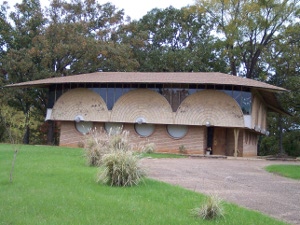 Bruce Goff - designed house
Bruce Goff - designed house
Texas is such a varied state that although we have crossed it a half-dozen times, and stayed in a half-dozen cities, we feel we are only slightly closer to beginning to understand it. This time we have been exploring the southeastern part of the state, an area which shares many characteristics with its eastern neighbor Louisiana.
 Bruce Goff - designed house
Bruce Goff - designed house
Between Paris and Nacogdoches we stopped briefly at Grand Saline, home of the Salt Palace. This used to be a building (housing the visitor's center and the Morton Salt Company museum) built out of salt, but the buildings had a tendency to melt; the current building is made of more conventional stuff, but still has a rock salt facade. The Morton Salt mine outside of town is said to contain enough salt to last another 20,000 years.
We detoured to Flint, Texas to snap yet another Bruce Goff home. This one was built in the 1970s. The house is in a development near the shore of Lake Palestine an immense lake ppopular with recreational boaters. Early settlers in the area had a certain sense of mischief -- we passed through the tiny towns of Reklaw and Sacul.
Nacogdoches, one of the first towns to be established by Anglo settlers, is the home of the Stephen F. Austin University, or SFA. History and education are two recurrent themes of the town, which has worked hard to document early homes and businesses. Many of the buildings around the central square are the original, one-hundred-plus-years-old structures although the businesses have changed many times. We particularly enjoyed reading about the first bank, whose manager one night cleared out the bank vaults and took off for South America, apparently successfully evading the law.
 Our first crawfish ranch
Our first crawfish ranch
The Big Thicket has been designated a National Preserve, but it's another one of the almost-too-late attempts to protect natural areas from encroaching development. Today it consists of several isolated spots managed for regrowth of the highly diverse plant and animal communities which lived there several hundred years ago. Logging and the development of towns along the railroad routes have disturbed the wilderness but since the Preserve was designated, in the 1970s, plant surveys are being carried out, hiking trails follow the old logging roads, and rangers carry out educational programs.
We have just started reading a book about Backwoodsmen of the Big Thicket which is exciting to us in terms of genealogy and social history. The book describes a little documented phenomenon of American social history -- one that was totally ignored in the history books of our youth. Backwoodsmen, says the introduction, were the original open range stockmen of the southern hardwood forests, whose free-range hogs fed on oak-tree mast, and whose cattle grazed between the trees, while the backwoods families, meanwhile, planted small gardens of corn, beans, and squash, and  Bolivar ferry to Galveston
gathered the abundant fruits, nuts, fish and game from the rich wet forest. Backwoodsmen continued in Texas until the range laws in the 1950s (fired by the large lumber companies) put an end to the free and common use of the Big Thicket as stock land.
Bolivar ferry to Galveston
gathered the abundant fruits, nuts, fish and game from the rich wet forest. Backwoodsmen continued in Texas until the range laws in the 1950s (fired by the large lumber companies) put an end to the free and common use of the Big Thicket as stock land.
After traveling through forests, off and on, for many days, we enjoy seeing the occasional pastures and rice paddies and grain fields. But we had never before seen a crawfish ranch! The presence of all these little mud chimneys seems quite deliberate because they were receiving a light sprinkling from irrigation sprayers.
Several miles farther, in Winnie, Texas, we had a chance to sample them at Al-T's Cajun Cuisine restaurant, where we shared helpings of shrimp gumbo and crawfish etouffee. We can recommend this place, which, judging by the number of trucks and cars, needs no advertising!